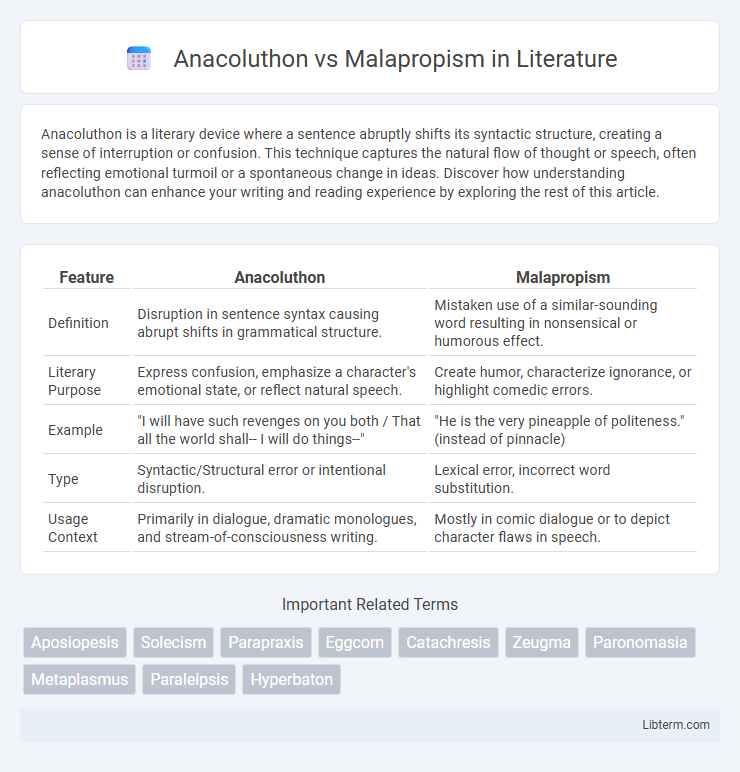Anacoluthon is a literary device where a sentence abruptly shifts its syntactic structure, creating a sense of interruption or confusion. This technique captures the natural flow of thought or speech, often reflecting emotional turmoil or a spontaneous change in ideas. Discover how understanding anacoluthon can enhance your writing and reading experience by exploring the rest of this article.
Table of Comparison
| Feature | Anacoluthon | Malapropism |
|---|---|---|
| Definition | Disruption in sentence syntax causing abrupt shifts in grammatical structure. | Mistaken use of a similar-sounding word resulting in nonsensical or humorous effect. |
| Literary Purpose | Express confusion, emphasize a character's emotional state, or reflect natural speech. | Create humor, characterize ignorance, or highlight comedic errors. |
| Example | "I will have such revenges on you both / That all the world shall-- I will do things--" | "He is the very pineapple of politeness." (instead of pinnacle) |
| Type | Syntactic/Structural error or intentional disruption. | Lexical error, incorrect word substitution. |
| Usage Context | Primarily in dialogue, dramatic monologues, and stream-of-consciousness writing. | Mostly in comic dialogue or to depict character flaws in speech. |
Understanding Anacoluthon: Definition and Examples
Anacoluthon is a rhetorical device characterized by an unexpected break in the syntax of a sentence, disrupting the grammatical structure and leaving the statement incomplete or abruptly shifting direction. This technique often reflects natural speech patterns or conveys a speaker's emotional state, as seen in examples like "I warned him that if he--well, it doesn't matter now." Unlike malapropism, which involves the misuse of a similar-sounding word for comic effect, anacoluthon emphasizes syntactic interruption rather than lexical confusion.
What Is Malapropism? Key Features Explained
Malapropism is the misuse of a word by confusing it with a similar-sounding word, often resulting in a humorous effect. Key features of malapropism include phonetic similarity between the incorrect and intended words, unintended meaning distortions, and frequent use in comedic dialogue or literature to highlight character traits. Unlike anacoluthon, which involves a sudden break in sentence structure, malapropism specifically centers on lexical errors that affect clarity and tone.
Grammatical Structure: Anacoluthon in Sentences
Anacoluthon disrupts expected grammatical structure by abruptly shifting syntax within a sentence, causing a break in the flow of thought and creating a fragmented or incomplete sentence pattern. This rhetorical device contrasts with malapropism, which involves the misuse of similar-sounding words rather than syntactic disruption. Anacoluthon often reflects natural speech patterns or emphasizes emotional states by deliberately breaking conventional sentence rules.
Malapropism and Its Role in Humor
Malapropism, the humorous misuse of words that sound similar but have different meanings, plays a crucial role in comedy by creating confusion and amusement through linguistic errors. Unlike anacoluthon, which involves a sudden break in sentence structure, malapropism relies on the inadvertent substitution of incorrect words, often leading to witty misunderstandings and character-driven humor. This device is famously used in literature and theater, notably in Richard Sheridan's play "The Rivals," where Mrs. Malaprop's linguistic blunders contribute to the comedic effect.
Common Causes of Anacoluthon in Speech and Writing
Anacoluthon often arises in speech and writing due to sudden shifts in thought, interruptions, or emotional stress, causing a break in grammatical sequence and leading to disjointed sentences. This contrasts with malapropism, which stems from the misuse of similar-sounding words, resulting in humorous or nonsensical expressions. Identifying anacoluthon requires attention to disrupted syntax and incomplete ideas, commonly triggered by spontaneous or informal communication contexts.
Famous Malapropism Instances in Literature
Famous malapropism instances in literature prominently appear in Richard Brinsley Sheridan's play *The Rivals*, where Mrs. Malaprop humorously misuses words like "allegory" instead of "allergy." Another notable example is in Shakespeare's *Much Ado About Nothing*, where Dogberry's malapropisms such as "comprehend" instead of "apprehend" create comic effect. These literary malapropisms illustrate the confusion and humor arising from incorrect word usage, contrasting with anacoluthon, which involves abrupt changes in sentence structure.
Anacoluthon vs Malapropism: Core Differences
Anacoluthon involves a sudden break or interruption in the grammatical structure of a sentence, creating a sense of confusion or spontaneity, while malapropism is the mistaken use of a word in place of a similar-sounding one, often resulting in a humorous effect. Anacoluthon disrupts syntax and flow, whereas malapropism primarily affects vocabulary and meaning. The core difference lies in the nature of disruption: Anacoluthon breaks sentence construction, malapropism misuses words.
Effects on Clarity and Communication
Anacoluthon disrupts sentence structure, causing sudden breaks that confuse readers and hinder clear communication by interrupting the logical flow. Malapropism involves the misuse of words with similar sounds, leading to unintended humor or misunderstandings that obscure the intended message. Both rhetorical devices impact clarity, but anacoluthon primarily breaks coherence, while malapropism distorts meaning through incorrect word choice.
How to Identify and Avoid Anacoluthon and Malapropism
Identifying anacoluthon involves spotting sudden breaks or shifts in sentence structure that disrupt logical flow, often causing confusion. Malapropism is recognized by the misuse of words that sound similar to the intended word but result in nonsensical or humorous meaning. To avoid anacoluthon, maintain consistent sentence syntax and plan sentence construction carefully, while preventing malapropism requires a strong vocabulary and proofreading to ensure correct word usage.
The Impact of Anacoluthon and Malapropism on Style and Tone
Anacoluthon disrupts the grammatical flow, creating a sense of spontaneity and emphasizing emotional intensity or confusion in a text, which can make the style feel more naturalistic or fragmented. Malapropism introduces humor and character depth through the misuse of words, often resulting in a playful or satirical tone that highlights linguistic errors for comedic effect. Both devices shape a writer's style by influencing how readers perceive voice and mood, with anacoluthon enhancing dramatic impact and malapropism contributing to wit and character portrayal.
Anacoluthon Infographic

 libterm.com
libterm.com